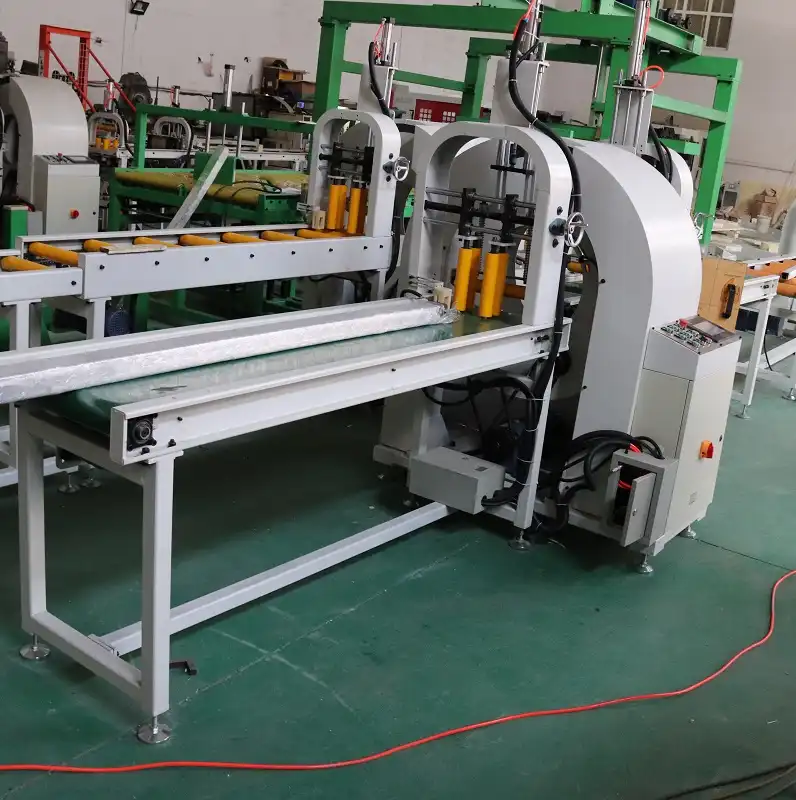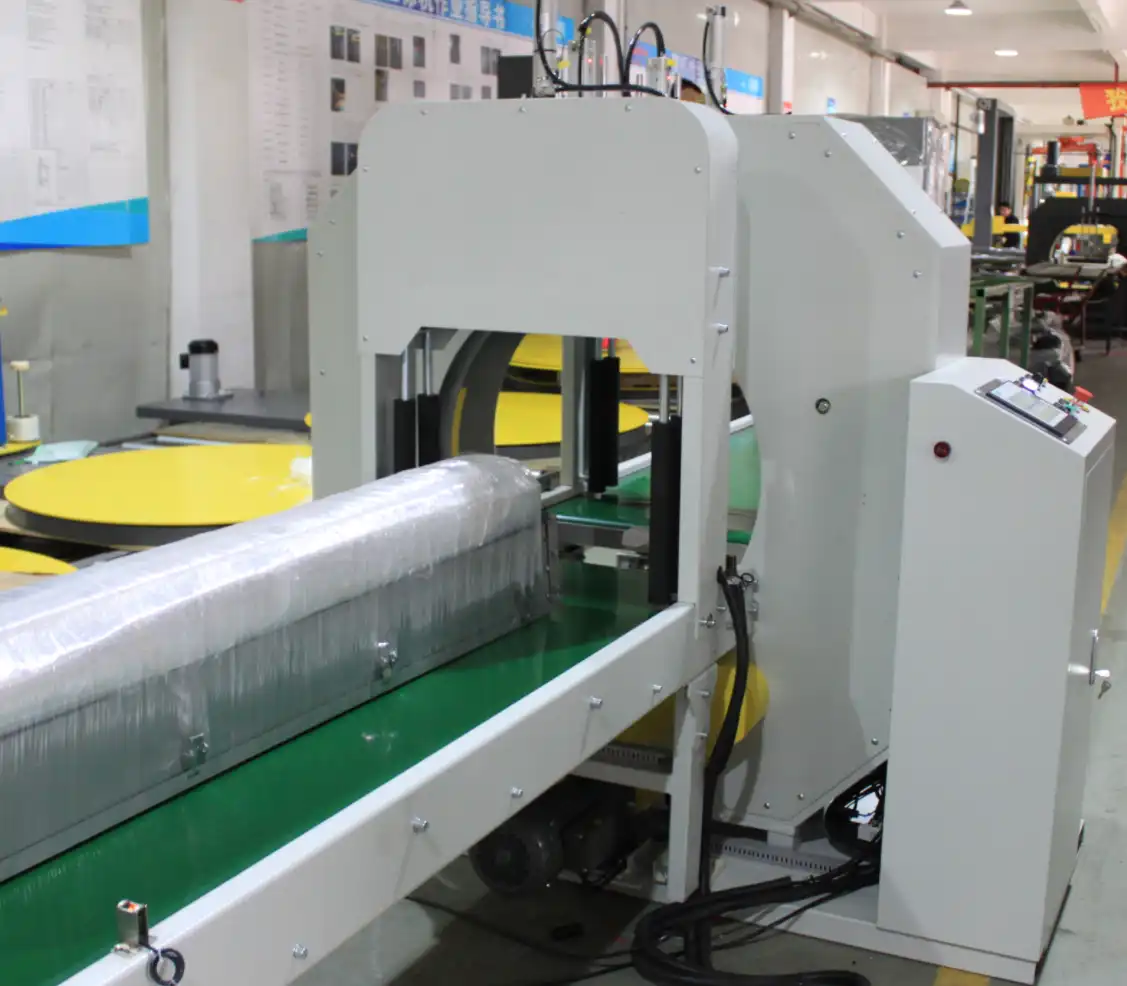Selecting the Optimal Full-Automatic Rod Film Wrapping Machine for Your Operation
Choosing the right automated packaging equipment is a critical decision for any fabrication or manufacturing facility handling long products like rods, bars, tubes, or extrusions. A Full-Automatic Rod Film Wrapping Machine streamlines the packaging process, improves product protection, and enhances overall operational efficiency. This guide outlines the key factors to consider when selecting a machine that best fits your specific requirements.
Why Automate Rod Wrapping?
Transitioning from manual or semi-automatic wrapping to a fully automated system offers significant advantages:
Enhanced Throughput and Efficiency
Full automation dramatically increases packaging speed compared to manual methods. This allows facilities to handle higher production volumes, reduce bottlenecks, and meet demanding schedules without adding labor. Consistent cycle times lead to predictable output.

Consistent Wrap Quality and Product Protection
Automated systems apply stretch film with consistent tension and overlap, ensuring a uniform, secure wrap every time. This minimizes the risk of product damage during handling, storage, and transit, preserving the quality and appearance of rods, bars, or profiles. Proper wrapping protects against scratches, moisture, and contaminants.
Reduced Labor Costs and Material Waste
Automation redeploys labor from repetitive wrapping tasks to more value-added activities. Precise machine control over film application, including pre-stretch capabilities (often up to 250-300%), optimizes film usage and significantly reduces material waste compared to manual wrapping, leading to direct cost savings.
Key Specifications for Rod Wrapping Machines
Evaluating the technical specifications is crucial for selecting a suitable machine:
Handling Capacity (Size, Weight, Shape)
- Product Dimensions: Verify the machine's minimum and maximum acceptable product length, diameter (for round items), or cross-section (for profiles).
- Weight Capacity: Ensure the conveyor system and wrapping mechanism can handle the weight of your heaviest products or bundles.
- Product Shape: Confirm suitability for your specific product shapes (round, square, rectangular, irregular profiles). Some machines offer specialized guides or supports.
Wrapping Speed and Cycle Time
- Rotational Speed (RPM): Indicates how quickly the film carriage revolves around the product.
- Conveyor Speed: Determines how fast products move through the machine.
- Overall Cycle Time: The total time required to wrap one product or bundle, including infeed, wrapping, cutting, and outfeed. Match this to your production rate needs (e.g., bundles per hour).

automatic horizontal stretch wrapper Film Delivery System
- Pre-stretch: Look for powered pre-stretch systems that elongate the film before application. Higher pre-stretch ratios (e.g., 250%) maximize film yield and improve load containment.
- Tension Control: Precise electronic tension control ensures consistent film application regardless of roll diameter or wrapping speed.
- Film Type Compatibility: Ensure the machine works efficiently with your desired film type (e.g., LLDPE stretch film, VCI film for corrosion protection) and gauge.
Machine Construction and Durability
- Frame and Components: Favor machines with heavy-duty steel frames and high-quality components designed for industrial environments.
- Reliability: Research manufacturer reputation and machine reliability records. Downtime can negate efficiency gains.
Essential Features and Customization
Beyond core specifications, consider these features:
Control Systems and User Interface
- PLC Control: Programmable Logic Controllers (PLCs) offer reliability and flexibility.
- HMI: A user-friendly Human-Machine Interface (HMI), often a touchscreen, simplifies setup, operation, parameter adjustments (e.g., wrap counts, overlap), and troubleshooting.
Infeed and Outfeed Conveyor Systems
- Powered Conveyors: Essential for automation, ensuring smooth product transfer into and out of the wrapping zone.
- Integration: Consider how the conveyors will integrate with existing production lines or material handling equipment. Options may include belt, roller, or chain conveyors.
Cutting and Clamping Mechanisms
- Automatic Film Cut & Clamp: A reliable automatic system that cuts the film tail and secures it at the end of the cycle is crucial for full automation. Hot wire or blade cutters are common.
Adaptability for Different Products
- Adjustable Guides/Rollers: Look for easy adjustments to accommodate varying product sizes without extensive changeover time.
- Programmable Recipes: The ability to store wrapping parameters for different products simplifies changeovers.
Integrating Wrapping Systems into Your Workflow
Compatibility with Existing Lines
Ensure the machine's footprint, height, and conveyor configuration fit seamlessly into your current production layout. Consider upstream and downstream processes.
Data Connectivity (IIoT Capabilities)
Modern machines may offer Ethernet connectivity for integration with plant management systems (MES, ERP). This enables remote monitoring, data logging (OEE), diagnostics, and predictive maintenance insights, aligning with Industry 4.0 initiatives.
Safety Considerations for Automated Packaging
Operator safety is paramount:
Guarding and Emergency Stops
- Safety Fencing/Guarding: The wrapping zone should be enclosed with safety guarding and interlocked access doors to prevent operator entry during operation.
- Emergency Stops (E-stops): Ensure easily accessible E-stop buttons are strategically placed around the machine.
Compliance with Safety Standards
Verify the machine complies with relevant safety standards, such as those outlined by OSHA in the U.S. or equivalent regional bodies (e.g., CE marking in Europe). Look for certifications from recognized bodies. Reputable suppliers like those affiliated with PMMI, The Association for Packaging and Processing Technologies, often adhere to high safety standards.
Evaluating Return on Investment (ROI)
Justify the investment by analyzing the financial benefits:
Calculating Payback Period
Estimate the time it will take for savings (labor reduction, material savings, increased throughput, reduced damage) to recoup the initial machine cost.
- ROI (%) = (Net Profit / Cost of Investment) x 100
- Payback Period = Cost of Investment / Annual Savings
Factoring in Maintenance and Consumables
Include ongoing costs like preventive maintenance, spare parts, and film consumption in your calculations for a realistic assessment.
Assessing Energy Consumption
Consider the machine's power requirements and energy efficiency. Energy-efficient designs can lower long-term operating costs.
Making the Right Choice: A Step-by-Step Approach
Define Your Requirements Clearly
Document your product specifications (size, weight, shape), required throughput, current packaging costs, integration needs, and budget.
Research and Compare Suppliers
Identify reputable manufacturers specializing in horizontal or orbital wrapping machines. Compare specifications, features, warranty, and after-sales support.
Request Demonstrations and References
Whenever possible, see the machine operate, preferably with your own products. Ask for references from similar companies to gauge real-world performance and supplier reliability.
Conclusion: Strategic Investment in Packaging Automation
Selecting the right full-automatic rod film wrapping machine is more than just a purchase; it's a strategic investment in your operation's efficiency, product quality, and cost-effectiveness. By thoroughly evaluating technical specifications, features, safety compliance, integration potential, and ROI, you can choose a system that provides reliable performance and supports your business goals for years to come. Careful consideration during the selection process ensures the chosen equipment delivers tangible benefits in a competitive manufacturing landscape.
